Remembering the Telegraphist Air Gunners

copyright © Wartime Heritage Association
Website hosting courtesy of Register.com - a web.com company
Wartime Heritage
ASSOCIATION

Remembering Lionel Reginald James
Telegraphist Air Gunner WWII
With England in the height of World War II in December of 1943, Lionel
James, born on December 26, 1925, joined the Fleet Air Arm Royal Navy. Born in
Newport, Gwent, South Wales he was the son of Arthur Leonard James and Violet
Maud James. The realities of war were not unknown to Lionel as his his father,
Arthur, had enlisted in the army during World War I and suffered throughout his
life from the effects of mustard gas encountered while in the trenches.
Lionel was the second of three sons, his older brother Leonard Charles, born
in 1923, enlisted in the Army, and his younger brother, Alan Royston, born in
1929, completed national service in the Royal Air Force.
A reconstruction of his Lionel’s service career follows:
January 26, 1944 - March 3, 1944
HMS Royal Arthur
In January, Lionel reported to HMS Royal Arthur, in Skegness, Lincolnshire.
This Royal Navy land base was a former Butlin's holiday camp where recruits had
their first six weeks of induction to Navy service.
March 4, 1944 - June 3, 1944
HMS St Vincent
Having completed basic training, Lionel transferred to HMS St.
Vincent where he joined Telegraphist Air Gunners Course 64.
Here they learned the hard work of life of parade square
bashing, morning inspections and school work. In June, 1944 he
was one of forty-two recruits selected to continue his training at
No. 1 TAG School at East Camp, RCAF Station Yarmouth, Nova Scotia
in Canada and becomes a member of Course 64A. Training in
Canada was for those recruits the Navy considered would be
successful in their courses and would provide training away from
the dangers of wartime England, particularly for the air training.
June 4, 1944 - Jane 5, 1944
HMS Waxwing
TAG Course 64A recruits, bound for Canada, were posted to
HMS Waxwing, a shore base on the Clyde used by Royal Navy
personnel en route to Canada.
June 6, 1944 - March 20, 1945
RCAF Yarmouth, Naval Air Gunner School (East Camp)
The Queen Mary departed Gourock, Scotland for New York,
with 4,898 passengers and a crew of 1,103 on June 17, 1944
arriving in New York on June 23, 1944. The recruits would stay at
the Royal Navy service camp at Astbury Park, New Jersey. The
camp had been prior to the war holiday apartments for New
Yorkers. The Royal Navy barracks comprised two hotels which were
fenced and had a center forecourt used as a parade ground.
From there, the group would travel by train to Boston and to
St. John, New Brunswick in Canada. From St. John they crossed the
Bay of Fundy to Digby in Nova Scotia on the Princess Helene and by
train to Yarmouth.
Training began almost immediately after a few days to settle
into the camp routine. Ground school and in-flight training took
about nine months. The TAGs received training in Morse code,
Radio Operations, Discipline, Gunnery, Naval regulations, and flight
experience. In-flight air experience included proper sending and
receiving communication techniques and air gunnery training while
flying as crew in Fairey Swordfish and Avro Anson aircraft.
The goal of training was to produce air gunners for use on
British aircraft carriers. Trained in wireless communication and
gunnery, their role was to maintain communication between planes
and ships and to act as rear gunners on various types of aircraft.
Having learned proficiency in Morse code, wireless theory,
gunnery, and procedures to communicate with other airborne
aircraft and with the fleet, the TAGs would serve on carrier ships in
both the Atlantic and Pacific and participated in many of the
important campaigns during World War II.
On the evening of October 20, 1944, four of Lionel’s Course
mates, John Arnold Bennett, Albert David Brookes, Raymond Edgar
Stanier, and Henry Taylor, were killed when two Anson aircraft on a
training flight collided in mid-air. They were buried in Mountain
Cemetery, Yarmouth with full military honours.
On March 3, 1945 No 1 NAGS ceased TAG training and Course
64A with 44 graduates was the last course to finish at No 1 Naval Air
Gunners School.
With the closing of East Camp, Lionel was temporarily posted
until transfer to HMS Saker on March 21, 1945.
Royal Naval personnel serving in the United States of America
are assigned to HMS Saker.
March 21, 1945 - May 26, 1945
HMS Saker (RNAS Saker, Brunswick, Maine - 738 Squadron)
U.S.N.A.S Brunswick (738 Squadron - May 23, 1945)
The original mission of NAS Brunswick was to train and form
up Royal Navy Fleet Arm pilots to fly squadrons of the Chance
Vought F4U Corsair and the Grumman TBF Avenger and F6F Hellcat
for the British Naval Command. Lionel completed advanced training
at HMS Saker with Naval Air Squadron 738, Royal Navy Fleet Air Arm.
May 29, 1945 - June 20, 1945
HMS Daedalus
With the completion of training, Lionel returned to the United
Kingdom, posted initially to HMS Daedalus awaiting his posting to
HMS Nightjar.
June 21, 1945 - August 12, 1945
HMS Nightjar (NAS Inskip)
Lionel was now assigned to 763 Squadron at HMS Nightjar, a Fleet Air Arm airfield near the village of Inskip, Lancashire,
England.
August 13, 1945 - January 11, 1946
HMS Golden Hind
(820 Squadron October 1945)
With the war in Europe at an end, efforts began in the United Kingdom to put together the fleet of warships which were
initially to be based in Sydney and destined to take part in the war against Japan. Lionel was assigned the shore base in
Sydney, HMS Golden Hind, just before the formal Japanese surrender on September 2, 1945.
He was posted to 820 Squadron in October 1945 on the aircraft carrier HMS Indefatigable that remained in the Pacific
for some time, finally returning to the UK in March 1946. Lionel, however, was posted from HMS Indefatigable to HMS
Nabstock in January 1945.
January 12, 1946 - May 12, 1946
HMS Nabstock
The British Navy needed airfields to provide carriers with trained crews and serviceable aircraft, and to supply aircraft
to meet requirements. There was a need to provide airfield facilities more quickly and economically. The concept of Mobile
Operational Naval Air Bases was developed, and established in Australia with the requirements of the British Pacific Fleet.
MONAB VI was commissioned as HMS Nabstock at RAAF Maryborough, Queensland, on June 1st 1945; however, with the
end of the Pacific war, HMS Nabstock began scaling down operations. There were no new arrivals after January 1946. The
last front line unit departed in April, 1946. April and May were spent packing up the MONAB equipment and stores, along with
preparing the airfield for return to the RAAF. Lionel was stationed here until May 12, 1946 after which he returned to the
United Kingdom.
May 13, 1946 - August 23, 1946
HMS Deadalus
The return to the United Kingdom was at HMS Daedalus at Lee on Solent, Portsmouth.
August 24, 1946 - October 29, 1946
HMS Deadalus III
HMS Daedalus III was an accommodation and release centre at Lee on Solent and Bedhampton between 1943 and 1947.
Post War Years
Discharged from his Military Service with the Royal Navy,
Fleet Air Arm, on October 29, 1946., Lionel worked for the
railways until he moved to London in the 1950’s to “seek his
fortune” as he used to joke.
He obtained a position at Walls in 1956 as company auditor,
auditing the books and checking on supply shipments, a position he
held until retirement at the age of sixty-five. In 1967 he bought a
flat at 64a Willow Tree Lane, Hayes, Middlesex, an address with the
same number and letter as his Telegraphist Air Gunner Course.
He married in 1972 and was the father of one daughter,
Nikki. “He was unfailingly kind and fair. He made everyone feel
good and was amazing at telling stories, silly ones that would
have everyone on the edge of their seat until the end when we
would all realise he was pulling our leg.”
Lionel didn’t talk much about the war years, maintaining that
war was a very bad thing. Once asked about war medals he
responded, “everyone who served was a hero and that maybe one
man would be given a medal for something whilst another could do
something equally as worthy and not been seen so, in my eyes,
everyone was a hero as they all did their part however big or
small”.
Lionel grew runner beans and tomatoes in his greenhouse and
seemed to be so good at it that he always had far too many of
either and would share them out among all the neighbours. He
loved roast potatoes and was most particular how his steak was
cooked but then on the other hand another evening he would
happily eat egg and chips.
His daughter recalls: Dad was unfailingly prompt and never
once do I recall him being late for anything. Even if driving from
one end of the country to the other he could be guaranteed to
arrive within a minute of the appointed time. One day, after he
retired, he was due to visit me and was a few minutes late which
was so out of character and had never before happened that I was
convinced he had met with an accident. He laughed and
apologised and said as he was retired he thought he should take
things easy but had not realised that in doing so he had managed to
be late!
Throughout his life, Lionel was never sick; however, his
retirement years were short due to illness. Knowing nothing could
be done, Lionel managed to keep the seriousness of his illness to
himself until the last few weeks of his life when it could no longer be concealed. But, right to the last, he had any relatives
who had discovered the truth and all the doctors and nursing staff attending him convince his daughter all would be well and
would only let them admit they were being overly optimistic a bit at a time each day all to save his daughter from being sad.
The kind, loyal, and gentle man displayed an heroic spirit to the end. Lionel Reginald James died on July 26, 1996.
He is remembered by his daughter, Nikki, who shares his stories and life with Lionel’s two grandchildren, Rhiannon
(1997) and Aiden (1999).
Source:
Nikki James
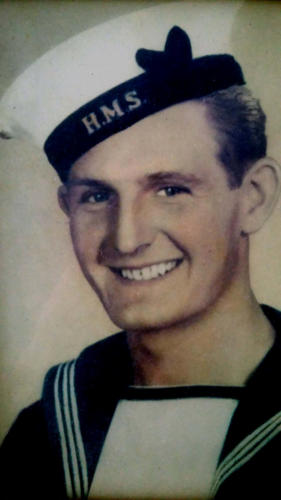
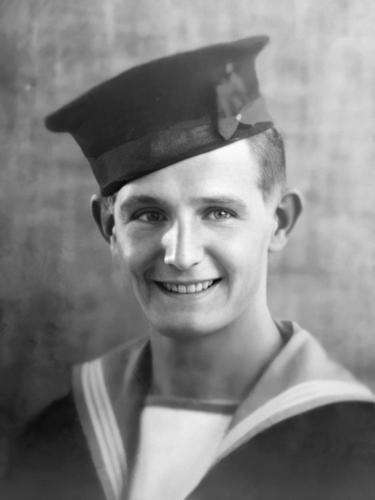
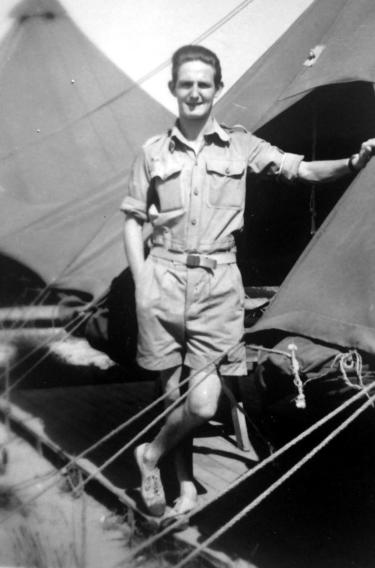
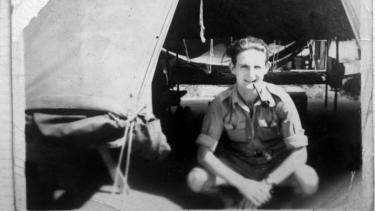
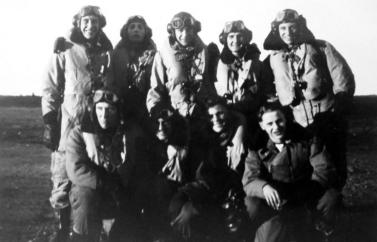
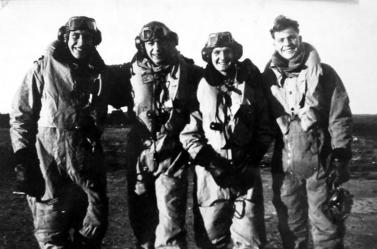
(Left to right) Cyrel Holmes, Roy Lepper,
Lionel James, and Fred Shorter
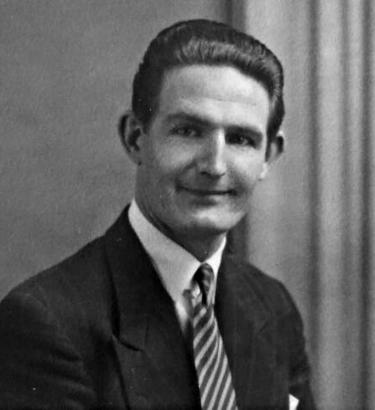
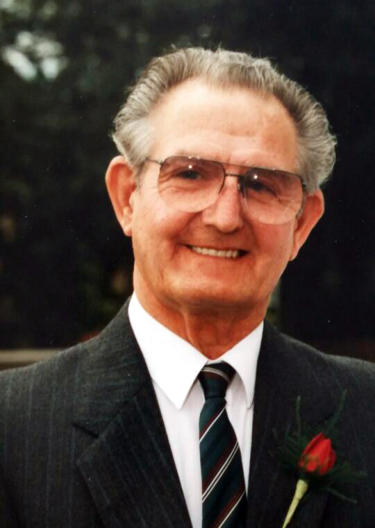
Lionel James - 1950
Lionel James 1992


- World War I - Menu
- WWI Stories and Articles
- Photos - Yarmouth Soldiers
- Selection of World War I Songs
- WWI Casualties of Yarmouth, NS
- Those Who Served - Yarmouth, NS
- WWI Casualties Digby Co. NS
- WWI Casualties Shelburne Co. NS
- Merchant Mariners (1915) Yarmouth, NS
- Canadian Forestry Corps - Non Yarmouth Birth/Residence Enlistments
- US Draft Registry - Yarmouth NS Born


- World War II - Menu
- WWII Stories and Articles
- Telegraphist Air Gunners
- WWII Casualties of Nova Scotia
- US Casualties with NS Connection
- Far East/Pacific Casualties with NS Connection
- Merchant Navy Casualties Nova Scotia
- Nova Scotia WWII Casualties Holten Canadian War Cemetery
- D-Day Casualties - Nova Scotia
- CANLOAN Program Casualties - Nova Scotia
- Battle of the Bulge Casualties - Nova Scotia
- WWII Casualties Yarmouth NS
- Yarmouth Casualties - RCAF RAF Canadian Army WWII
- Yarmouth Co., Marrages WWII
- Casualties Non-Born/Residents with Connection to Yarmouth Co., Nova Scotia.
- WWII Casualties Digby Co., NS
- Non-Nova Scotian WWII Casualties Buried in Nova Scotia
- WWII RCAF Casualties Aged 16-18
- Brothers/Sisters Who Served - World War II













